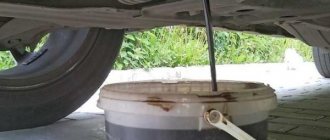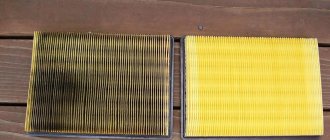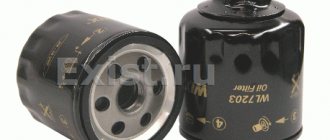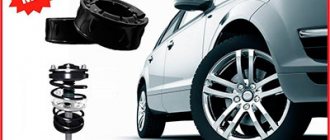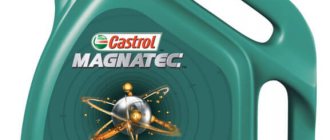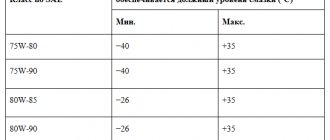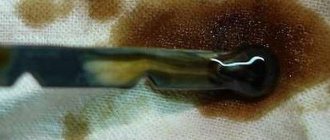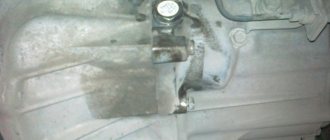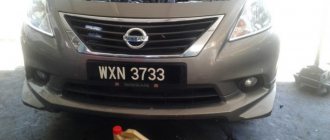Mitsubishi Lancer IX is a typical representative of the extensive family of C-class passenger cars, originally developed for the Japanese market. Appearing in local showrooms in 2000, it was sold under the name Cedia. Two years later, sales of the car began in North America and Australia, and in 2003, Lancer began to be sold in Europe (in Russia a year later). The ninth generation Lancer, like all previous ones, turned out to be in demand all over the world, including our country - the Japanese assembly has long been known for its excellent quality.
Instructions for changing engine oil in Mitsubishi Lancer 9.
But for domestic owners of this brand, the biggest problem is the high cost of repairs, so compliance with the scheduled oil change dates for Lancer 9 is not only the key to maximizing the life of the power unit, but also saving significant money on car repairs. Since the auto chemical market today is unusually large, even experienced owners have questions about purchasing suitable motor lubricant. And for many, the procedure itself, performed for the first time or after a long break, can cause difficulties, which we will try to resolve in this article.
Oil change interval
The automaker itself recommends changing the oil and oil filter after every 15 thousand kilometers. However, for Russian conditions, this interval should definitely be reduced - otherwise, as many owners of the ninth Lancer claim, they will have to deal with increased consumption of engine lubricant. This problem is especially true for those who have not purchased a new car, the odometer of which has exceeded the 100 thousand kilometers mark. However, as car service statistics show, even on new cars, problems with oil consumption began after driving 60 thousand km, if the oil change in the Lancer 9 engine was carried out within the scheduled time frame, that is, after 15 thousand km.
In principle, a lubricant replacement strategy focused solely on mileage is far from perfect. Especially for machines operated in difficult conditions. In megacities with their permanent traffic jams, the average owner's car is forced to spend a considerable amount of time in traffic jams, and more than half is spent sitting idle with the engine running or driving at a speed of about 5 - 10 km/h. This means that, having driven the notorious 15,000 km, the engine has worked about 700 or more hours during this time. When driving exclusively on a suburban highway at an average speed of 70 - 80 km/h, this figure will be slightly more than 200 hours. As you can see, the difference is significant.
Based on the above, determining when to change engine lubricant should be done individually, guided by factors such as driving circumstances, driving style, and road features. But even under the most favorable circumstances, this should be done at least every 10 thousand kilometers.
Not worth saving
There are many low-quality parts and unreliable manufacturers on the market. The characteristics of components may fully comply with those recommended by the manufacturer. But this does not mean that it is worth saving 10-20% compared to original spare parts. Poor quality parts can cause serious problems, such as:
- Filter jammed. The pressure rises in the oil compartment, the liquid begins to pass past the part and leak out. As a result, you need to change the oil and buy a new, high-quality filter.
- Part of the filter comes off and goes into the engine. This can lead to jamming and breakage. Moreover, the problem will arise instantly. Savings will result in spending on tow truck services, engine repairs, and the purchase of new, high-quality components.
Choosing engine oil
The viscosity index is considered the main criterion that you should pay attention to when deciding which oil to fill in Lancer 9. This indicator, according to the international SAE classification, demonstrates the dependence of the viscosity properties of the liquid on the outside temperature, which is important when starting the power unit in winter, when the thermometer needle drops well below zero, and also how much the fluidity of the oil changes under operating conditions in the most extreme mode. According to the recommendations of the automaker, the conditions for choosing an oily liquid suggest the possibility of using nine types of oils, depending on the operating conditions in a particular area (temperature):
| T< -35° C | T= -30° C | T= -20° C | T=-10° C | T= 0° C | T= 10° C | T= 20° C | T= 30° C | T= 40° C | Т>50°С |
| 20W40/20W50 | |||||||||
| 15W40/15W50 | |||||||||
| 10W40/10W50 | |||||||||
| 10W30 | |||||||||
| 0W40/5W40 | |||||||||
| 0W30/5W30 | |||||||||
The SAE viscosity index is not difficult to interpret. The number that appears in front of the letter W (from the word Winter) indicates at what minimum temperature the trouble-free start of the power unit is possible (the value 40 should be subtracted from the indicated number).
In other words, the 5W index means that such an oil is suitable for areas where the winter temperature almost never drops below -35° C. The number after the letter indicates high-temperature viscosity, but it is quite difficult to interpret, since this indicator is calculated based on the viscosity characteristics at temperature engine during intensive operation. This is an average indicator of the maximum and minimum viscosity of the fluid in the engine at temperatures of the order of 100 - 150 ° C. Simply put, the higher the number, the higher the viscosity of the motor lubricant in a hot engine.
Which oil is the best for the Lancer 9 engine can be seen from this table. Motor lubricants 0W40/5W40 are considered the most universal - they are suitable for the entire temperature range, but if the climate is not too hot, preference should be given to oils with viscosity indexes 0W30/5W30 - for our conditions they are the best.
If we are talking about the manufacturer, then the decision is made based on whether you are ready to overpay for the brand, being confident that this oil will definitely not let you down. Most car owners still prefer less famous and more affordable brands, changing the fluid a little more often. The optimal choice for the Mitsubishi Lancer 9 can be considered semi-synthetics from Shell - many car enthusiasts recommend using Helix Plus 10W40 for use in the summer and Helix 5W40 for driving in the winter (provided that the seasonal mileage is within 20 thousand kilometers or more). However, other oil brands have also proven themselves to be excellent - Mobile, Motul, Castrol.
Oil filter for Mitsubishi Lancer 9
The oil filter is an important part installed in the lubrication systems of the engine and gearbox. It is responsible for cleaning the liquid from various contaminants: burning, metal particles, etc.
The Lancer 9 engine oil filter is a quickly wearing part and must be periodically replaced. It may become excessively clogged or worn out. In any of these cases, a malfunction will lead to increased oil and fuel consumption, increased wear of parts, and disruption of normal operating conditions of the engine or transmission.
How much oil to pour into the Lancer 9 engine
The numbers that are indicated in the manuals for a specific car model assume the full volume of lubricant poured into the power unit at the factory, including the liquid filling the oil filter. When changing the oil, it is almost never possible to drain the amount of oil recommended by the car manufacturer - about 0.13 - 0.3 liters of waste oil remains in the engine. Many people do not take this fact into account, wondering why the level of drained motor fluid was less than expected. This is absolutely normal. Here are the oil volumes in the Lancer 9 engine depending on the modification of the power unit:
- 1.3 AT/MT (power 82.0 hp and volume 1299 cc) – 3.30 l;
- 1.6 AT/MT (power 98.0 hp and volume 1584 cc) – 3.30 l;
- 2.0 AT/MT (power 135.0 hp and volume 1997 cc) – 4.3 liters.
As practice shows, in the first two cases, three liter containers are enough, and for a two-liter engine you can purchase 4 liter canisters or one four-liter canister without overpaying for an extra liter.
What kind of oil to pour
The Japanese automaker Mitsubishi recommends using original oil or synthetic oil from Castrol in the Mitsubishi engine. On a 1.6 liter engine, about three liters of oil need to be replaced.
If, before replacement, you plan to completely flush the power unit, then you need to purchase the appropriate flushing fluid and 3.5 liters of lubricant. You will also need an oil plug gasket and a filter element for this job. It is better to use an oil filter in a Mitsubishi engine from Mann or an original one.
Necessary tool
Before replacing, you should make sure to purchase the following consumables:
- a new oil filter (an alternative to the original Mitsubishi MD 360935 product is the MANN W 610-3 filter);
- oil drain plug gasket (preferably original - MN 195854);
- motor oil itself, preferably synthetic.
The tools you will need are a 17 mm spanner/socket wrench, a rag, and if you can’t unscrew (or rather, tear off) the oil filter by hand, you will need a special filter puller. Well, don’t forget to prepare a suitable container for used lubricant. A 5-liter container is enough, it is desirable that it has wide edges - in this case, the risk of staining the place where the fluid is replaced will be minimal.
Which part should I choose?
Original Lancer 9 oil filter - MD360935. Manufacturer: TOKYO ROKI (Japan). Characteristics:
- original code - LFS708;
- filtering surface - 82940 mm 2;
- number of ribs - 55 pcs.;
- height and depth of ribs - 58x13 mm.
According to MITSUBISHI ASA catalog, model MZ690070 can be used as a replacement for the original. Part characteristics:
- manufacturer - Purflux (France);
- oil filter production code - LS287;
- filtering surface - 96,000 mm 2;
- number of corrugation ribs - 40 pcs.;
- height and depth of ribs - 80x15 mm.
These options are exactly suitable for this car model. You can also independently select components using the VIN code or in the MITSUBISHI ASA catalog.
Replacement algorithm
Before starting the procedure, it is advisable to warm up the car engine to operating temperature, for which it is enough to drive a distance of 5–10 km. Heated oil has greater fluidity (and, accordingly, lower viscosity), due to which the maximum volume of waste material can be drained. But if you intend to fill in a completely different motor lubricant, we strongly recommend flushing the power unit lubrication system with a special flushing fluid.
This is not difficult, although it will require additional effort from you: after draining the used fluid, you need to fill in the flushing fluid and let the engine run for about 10 - 15 minutes. And only after draining the flushing lubricant should you start replacing the oil filter.
Many experts consider this operation controversial, believing that, in addition to benefit, it can also cause harm (not all of the flushing fluid will drain, but the residue will mix with the new oil, which will lead to the formation of sediment and contamination of the new lubricant). In their opinion, it is still advisable to use the same brand of fluid as the previous oil when replacing.
So, here is a complete algorithm for how to change the oil in a Lancer 9 engine:
- We dismantle the right part of the lower protective casing of the power unit.
- We place a pre-prepared container for the waste liquid directly under the drain hole.
- We unscrew the drain plug, being careful at the very end so that the hot oil does not burn your hands or spill past the vessel.
- While the oil is draining from the drain neck of the Lancer 9 engine, use a metal brush to remove dirt from the plug and wipe it with a rag.
- When the waste stops dripping, carefully screw the plug into place, having first replaced the gasket with a new one.
- We try to unscrew the oil filter located on the rear wall of the Lancer IX cylinder block approximately in the area of cylinder No. 1. Usually it is not possible to move it by hand, in such cases we use a special oil filter puller. If you don't have one, you can take a flat-head screwdriver, break through the side of the filter and use this tool as an extension lever.
- Completely unscrew the oil filter from the cylinder block fitting.
- Before putting the filter in its original place, lubricate the sealing ring with a small amount of new grease, making sure that it is dry (some oil filters are factory treated with talcum powder or a special grease).
- We screw in the new filter, not forgetting to fill it approximately 65% with new lubricating fluid - this is necessary in order to prevent oil starvation of the engine when starting the power unit. By filling the oil filter with lubricant, we ensure that the oil channels of the lubrication system are filled as quickly as possible. After the oil filter sealing ring comes into contact with the block flange, tighten it ¾ of a turn by hand, without using a wrench.
- Remove the filler plug (on Mitsubishi Lancer engines, to do this you need to turn it 90° in a counterclockwise direction).
- We fill in new lubricant and install the plug in its original place.
- We start the engine and let it idle for about five minutes. We carefully monitor the oil pressure lamp: it should go out 3 - 5 seconds after the engine starts running.
- While the engine is running, check the oil filter and drain hole for fluid leaks.
- After stopping the power unit, we re-check the lubricant level and, if necessary, top up, tighten the filter and drain plug.
A timely oil change procedure on a Mitsubishi Lancer 9 allows you to avoid costly repairs that are inevitable if this operation is not performed in a timely manner. It is also important that the characteristics of the lubricant used comply with the car manufacturer’s recommendations. It should be understood that even for disciplined drivers, during normal vehicle operation, some consumption of engine oil is inevitable, depending on a large number of factors. Therefore, make it a habit to check the oil level about twice a month, or more often when using your vehicle heavily, and before every long-distance trip.
Changing the oil: step-by-step instructions
We offer you fairly simple instructions for changing the oil in a 1.6-liter Lancer 9 engine:
- First, you need to warm up the engine, which will increase the fluidity of the oil and allow it to drain completely. That is why it is necessary to drive a car onto an overpass or pit with a warmed-up engine.
- Next, unscrew the drain plug in the pan, placing a container of the required volume under the crankcase in advance.
- It usually takes about 20 minutes for the oil to drain completely. After this, you can try to unscrew the oil filter. This can be done manually, using a special puller, or by breaking through the filter element housing with a flat screwdriver. Proceed carefully, as there are heated metal elements of the power unit nearby, which can cause you to get burned if handled carelessly.
- Next, you can begin replacing the filter element. Pour a small amount of oil inside the filter, then lubricate the O-ring, install a new gasket in place and tighten the filter until it stops. Remember that you must tighten the filter exclusively by hand.
- Next we go under the car and tighten the drain plug.
- Carefully pour fresh oil into the engine. Usually you need to fill in about three liters of new lubricant, constantly monitoring its level with a dipstick.
- Next, start the engine and let it run for a few minutes. The first few seconds after starting, the low pressure light in the engine may come on. Soon it will go out and the engine will gain the required pressure in the system.
Important. You should not fill in too much auto lubricant, as this can lead to serious damage. It is better to underfill a little, and then, after checking with a dipstick, add the required amount, than to overfill and damage the engine.
The engine should be allowed to run for about 5 minutes, after which we turn it off, wait about 10 minutes, and check the lubrication level with a dipstick again, topping it up if necessary. At this point, all service work is completely completed, and you can use your car.
A mass-produced car with an elegant design
The first Lancer began production in 1973. It was conceived as a car for the general public. It had a comfortable interior for that time and rear-wheel drive. Whatever the car was called - Colt Lancer, Chrysler Lancer, Dodge/Plymouth Colt, Eagle Summit, Mitsubishi Carisma, Hindustan Lancer. Now the Japanese know it under the name Galant Fortis.
The first generation of cars was produced until 1981. The production of the 2nd generation Mitsubishi Lancer ended in 1987.
Generations 9 or 10 are considered the most common in our country today. However, there is confusion with their numbering. For example, the English Wikipedia refused to keep score at all. Russian Wikipedia considers the latest version to be the 10th generation. We will assume that both numbers, 9 and 10, have the right to exist.
The 9th-10th generation Mitsubishi Lancer has been produced since 2007 and is officially sold in Russia. Numerous videos show how great this car looks. The bodies - 5-seater sedans of the CY and CZ modifications - are equipped with 1.6 or 2-liter 16-valve injection engines. 2-liter engines are offered with turbocharging (295 hp) and without it (150 hp). The one and a half liter has a power of 109 hp. With. The modification with a turbocharged engine is the all-wheel drive EVO X model in the CZ body.
Determining conditions for choosing an oily liquid
To reduce the level of gasoline consumed and increase the performance of a Lancer car, to protect its engine from various critical circumstances, when choosing the optimal motor lubricant, it is customary to take into account the following significant principles:
- pour only the lubricant that is intended for Lancer cars; you should purchase only high-quality, original and certified;
- when carrying out the operation of switching the engine to another type of oil fluid, be sure to wash it with a special flushing agent;
- the older the engine, the higher the viscosity of the lubricant;
- The ideal option for this brand of car in the warm summer is a lubricant with a viscosity of 5W40. For the cold winter period, 0W30 brand auto lubricant will be most optimal.
Filling lubricant
Important! The use of lubricant of the brand that was used during production at the manufacturer’s plant is considered the most tested for the engine, guaranteeing uninterrupted operation of the machine for a long time.
Taking into account the characteristics of each motor, it is recommended to pour lubricant of a certain modification into it. In the service book, the manufacturer indicates the characteristic lubricating fluid of the manufacturer with a viscosity of 5W30, 5W40, 0W30.
Types of lubricating fluids
For this brand of transport, it is customary to use the best Japanese lubricants. But we should not forget that they are not suitable for our climate. If we talk about analogues, then the best option would be Mitsubishi:
- DiaQueen SM/GF-4 (Japanese production);
- Lubrolene SM-X is semi-synthetic, specially produced for GDI and Mivec engines and is a new product on our market;
- Motors Engine OIL - manufactured in Singapore, but since 2010 it has been actively used in official representative offices, and is advertised as the original, the affordable price meets all the requirements;
- Diamond is a synthetic lubricant, made in the USA (Chevron), based on consumer reviews, this brand has excellent recommendations.
You can also use lubricants labeled Mitsubishi Motors Genuine Parts. Taking into account operating conditions and climate, it is recommended to contact a dealer who can select the most suitable alternative brand for your vehicle.
Original oil (tolerances)
Official dealers of the company recommend pouring original Mitsubishi Motors oil with SAE viscosity OW-30, OW-40 , 5W-30 or 5W-40 and replacing it after 15 thousand kilometers .
When operating a vehicle in difficult conditions with frequent peak loads, replacement must be done more often, after approximately 8–10 thousand mileage .
For the Mitsubishi Corporation, lubricants for power plants are developed and supplied by the Japanese oil refining company Nippon Oil & Energy . Many Lancer owners are familiar with black canisters with a capacity of 1, 4, and 5 liters with the inscription ENGINE OIL.
GENUINE OIL SAE 5W-30 oil – front side of the canister.
GENUINE OIL SAE 5W-30 oil – back of the canister.
Articles
For a 4G18 with a volume of 1.6 liters, the following oils are quite suitable with excellent additive packages:
- Mitsubishi GENUINE OIL SAE 5W-30 – cleaning effect and increasing engine efficiency.
- Mitsubishi DiaQueen 5W-30 SM/GF-4 – eliminates corrosion and significantly reduces fuel consumption.
- Mitsubishi Diamond Evolution SAE 5W-30 is a high-quality synthetic lubricant based on hydrocracking.
DiaQueen 5W-30 SM/GF-4 oil in a metal can.
Diamond Evolution SAE 5W-30 oil in plastic cans.
Flushing the engine
If the car is used in difficult conditions or you are not sure of the quality of the oil and the service performed by the previous owner, then it is necessary to carry out the so-called engine flushing procedure.
Such engine flushing is performed as follows:
- It is necessary to drain the old oil, after which, without changing the filter element, close the drain neck with a plug and pour 3.5 - 4 liters of cleaning fluid into the power unit.
- We start the engine and let it run for about 10 minutes.
- After 10 minutes of operation, turn off the engine, unscrew the drain plug and drain the liquid to clean the engine.
- Next, all you have to do is change the filter elements and pour new oil into the engine. At this point, all work on cleaning the engine is completely completed. It is recommended to carry out such cleaning once every 50,000 kilometers of the vehicle.
